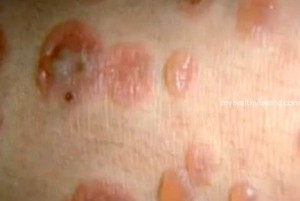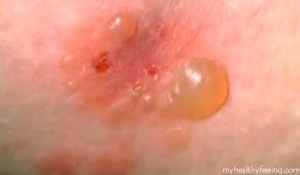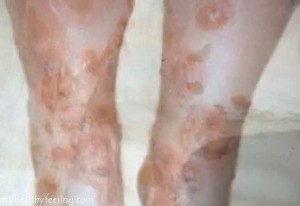Bullous pemphigoid is a persistent, though rare disorder of the skin characterized by the appearance of large, fluid-filled bullae or blisters in the skin. The condition can affect anyone but is more commonly found among older adults.
Bullous pemphigoid is caused due an abnormal response of the immune system against a thin layer of tissue that is present below the outer layer. The reasons for immune system attack on the tissue are unknown.
Bullous pemphigoid can be treated with immunosuppressant drugs that inhibit the activities of the immune system, thereby alleviating the symptoms. However, such drugs have serious side effects and their consumption should be carefully monitored. The condition generally does not result in fatalities, other than in older people who have a poor immune system or are in a state of general health decay.
Symptoms of bullous pemphigoid
Bullous pemphigoid is characterized by the primary symptom of blisters, which show the following features:
- The blisters are filled with fluid, large in size and do not rupture easily when touched
- The location of a torn blister tends to be sensitive and painful
- The skin surrounding the blisters has a normal appearance, with a reddish shade to it in individuals with lighter skin and a darker than normal shade in people with dark skin
- The fluid that is inside the blisters is generally clear, but may contain blood on occasions
- The blisters may appear at any part of the body but are more common on the inner thighs, abdomen, arms and the groin. The blisters generally tend to appear along the folds or creases of the skin, in areas such as the skin folds on the inner regions of a joint
Some other signs of bullous pemphigoid include:
- Hives in the form of elevated, dark or reddish patches of inflamed skin may occur before the development of blisters. In certain cases, bullous pemphigoid may only result in the formation of hives.
- The oral cavity may develop sores or blisters. On occasions, other mucous membranes may also get affected by the condition.
- The affected regions of the skin tend to be irritable and very itchy
Bullous pemphigoid does not give rise to any serious complications, other than in older individuals who are in poor health.
- Such individuals may suffer from infection of ruptured blisters by bacteria or other germs and/or spreading of the infection to other tissues and organs.
- The constant itching and painful blisters do affect the daily life of individuals affected by it. Larger the size of the blister, great is the level of discomfort and disruption. Simple daily life activities such as sleeping comfortably, maintaining personal hygiene, eating and drinking and wearing of shoes and certain kinds of clothing can become very difficult due to the blisters and sores in the mouth, if any.
- Additionally, the potential embarrassment that one may have to endure due to the grotesque appearance of the skin can also lead to social and psychological problems.
Causes of bullous pemphigoid
The exact causes of bullous pemphigoid are unknown. It is caused due to a dysfunction of the immune system, but the reasons for this malfunction are not known.
The immune system of the body constantly produces antibodies to counter the effects of viruses, bacteria and other potentially harmful microorganisms. In a similar manner and for reasons unknown, the immune system incorrectly develops antibodies for a particular tissue in the body. This tissue is made up of a thin layer of fibers that connect the dermis to the inner layer of the skin called the epidermis. The creation of such antibodies results in inflammation of the skin that leads to the development of hives and blisters as well itching, associated with bullous pemphigoid.
There are no known factors that cause this reaction of the immune system. The causes of bullous pemphigoid are random at best. However, studies indicate that the condition may also get triggered by certain factors such as:
- The use of ultraviolet light therapy to cure inflammatory disorders or certain skin diseases
- Consumption of prescription drugs used to treat fluid retention or rheumatoid arthritis
- The use of radiation therapy for treating cancer
Individuals who are sixty years or older are at greater risk to develop bullous pemphigoid than others, while people in their 80s are at the highest level of risk to develop the disorder
Treatment of bullous pemphigoid
Treatment for bullous pemphigoid is aimed at alleviating the symptoms and reducing the itching as well as healing the damaged skin. Such treatment may be required for many years.
The treatment involves intake of the following medications:
- Corticosteroids: This medication may be taken in the oral form or can be applied directly on the blisters in its topical form. There are many side effects to the drug. Prolonged use of oral corticosteroids can result in diabetes, weakening of the bones, hypertension, cataracts, high cholesterol and other complications. Prolonged use of topical corticosteroid can lead to thinning of the skin and other skin disorders.
- Immunosuppressant drugs: They inhibit the activity of the immune system to produce antibodies and can be consumed along with corticosteroids for greater effect in treating bullous pemphigoid and to minimize the risks of corticosteroid use.
- The doctor may also prescribe other anti-inflammatory medications such as nicotinamide, methotrexate, dapsone, tetracycline, etc. to treat bullous pemphigoid
Bullous Pemphigoid pictures



GRILLZ SALE – https://www.msmjewelers.com/collections/pendants-necklaces-for-men | MSM Jewelers has Grillz at low prices! Visit MSM Jewelers at https://www.msmjewelers.com/collections/pendants-necklaces-for-men to save big on fashionable jewelry! #Jewelry #Grillz